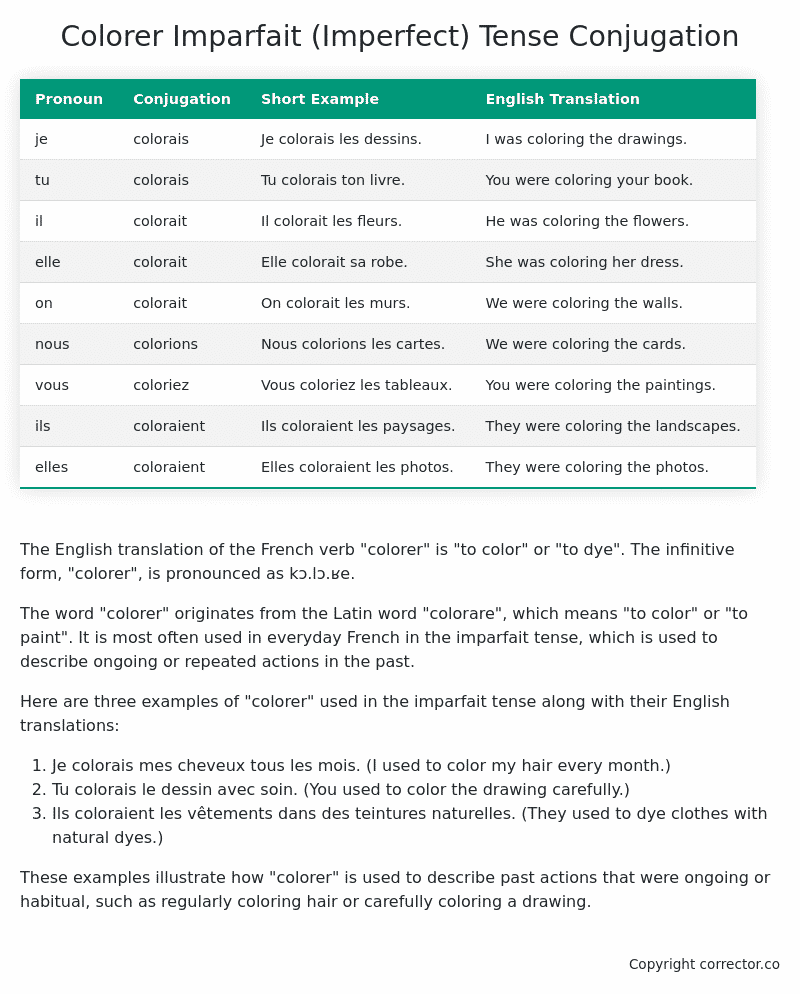Imparfait (Imperfect) Tense Conjugation of the French Verb colorer
Introduction to the verb colorer
The English translation of the French verb “colorer” is “to color” or “to dye”. The infinitive form, “colorer”, is pronounced as kɔ.lɔ.ʁe.
The word “colorer” originates from the Latin word “colorare”, which means “to color” or “to paint”. It is most often used in everyday French in the imparfait tense, which is used to describe ongoing or repeated actions in the past.
Here are three examples of “colorer” used in the imparfait tense along with their English translations:
- Je colorais mes cheveux tous les mois. (I used to color my hair every month.)
- Tu colorais le dessin avec soin. (You used to color the drawing carefully.)
- Ils coloraient les vêtements dans des teintures naturelles. (They used to dye clothes with natural dyes.)
These examples illustrate how “colorer” is used to describe past actions that were ongoing or habitual, such as regularly coloring hair or carefully coloring a drawing.
Table of the Imparfait (Imperfect) Tense Conjugation of colorer
| Pronoun | Conjugation | Short Example | English Translation |
|---|---|---|---|
| je | colorais | Je colorais les dessins. | I was coloring the drawings. |
| tu | colorais | Tu colorais ton livre. | You were coloring your book. |
| il | colorait | Il colorait les fleurs. | He was coloring the flowers. |
| elle | colorait | Elle colorait sa robe. | She was coloring her dress. |
| on | colorait | On colorait les murs. | We were coloring the walls. |
| nous | colorions | Nous colorions les cartes. | We were coloring the cards. |
| vous | coloriez | Vous coloriez les tableaux. | You were coloring the paintings. |
| ils | coloraient | Ils coloraient les paysages. | They were coloring the landscapes. |
| elles | coloraient | Elles coloraient les photos. | They were coloring the photos. |
Other Conjugations for Colorer.
Le Present (Present Tense) Conjugation of the French Verb colorer
Imparfait (Imperfect) Tense Conjugation of the French Verb colorer (You’re reading it right now!)
Passé Simple (Simple Past) Tense Conjugation of the French Verb colorer
Passé Composé (Present Perfect) Tense Conjugation of the French Verb colorer
Futur Simple (Simple Future) Tense Conjugation of the French Verb colorer
Futur Proche (Near Future) Tense Conjugation of the French Verb colorer
Plus-que-parfait (Pluperfect) Tense Conjugation of the French Verb colorer
Passé Antérieur (Past Anterior) Tense Conjugation of the French Verb colorer
Futur Antérieur (Future Anterior) Tense Conjugation of the French Verb colorer
Subjonctif Présent (Subjunctive Present) Tense Conjugation of the French Verb colorer
Subjonctif Passé (Subjunctive Past) Tense Conjugation of the French Verb colorer
Subjonctif Imparfait (Subjunctive Imperfect) Tense Conjugation of the French Verb colorer
Subjonctif Plus-que-parfait (Subjunctive Pluperfect) Tense Conjugation of the French Verb colorer
Conditionnel Présent (Conditional Present) Tense Conjugation of the French Verb colorer
Conditionnel Passé (Conditional Past) Tense Conjugation of the French Verb colorer
Conditionnel Passé II (Conditional Past II) Tense Conjugation of the French Verb colorer
L’impératif Présent (Imperative Present) Tense Conjugation of the French Verb colorer
L’impératif Passé (Imperative Past) Tense Conjugation of the French Verb colorer
L’infinitif Présent (Infinitive Present) Tense Conjugation of the French Verb colorer
L’infinitif Passé (Infinitive Past) Tense Conjugation of the French Verb colorer
Le Participe Présent (Present Participle) Tense Conjugation of the French Verb colorer
Le Participe Passé (Past Participle) Tense Conjugation of the French Verb colorer
Struggling with French verbs or the language in general? Why not use our free French Grammar Checker – no registration required!
Get a FREE Download Study Sheet of this Conjugation 🔥
Simply right click the image below, click “save image” and get your free reference for the colorer imparfait tense conjugation!

Colorer – About the French Imparfait Tense
NOTE: To take a deep dive into all the French tenses then see our article on Mastering French Tense Conjugation.
Formation of the Imparfait Tense
For regular -er verbs:
For regular -ir verbs
For regular -re verbs
Common Everyday Usage Patterns
Description of Past Habits
Background Information
Mental and Emotional States
It’s employed to express emotions, thoughts, or physical sensations in the past. For example: “J’étais content quand il est arrivé.” (I was happy when he arrived.)
Ongoing Actions
Points to Note About the Imparfait Tense
Passé Composé vs. Imparfait
Conditional
Si Clauses
Narration
I hope you enjoyed this article on the verb colorer. Still in a learning mood? Check out another TOTALLY random French verb imparfait conjugation!


